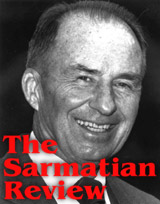| This Issue | Back Issues | Editorial Board | Contact Information |

Russia in the Twentieth Century
Reviewer: Patricia A. Gajda
Russia in the Twentieth Century
By M. K. Dziewanowski. 6th edition. Upper Saddle River, New Jersey: Prentice Hall, 2003 xxvii + 424 pages. Index. Paper. $53.33 on Amazon.com.
M. K. Dziewanowski's new book is the sixth edition of a work formerly titled A History of Soviet Russia and Its Aftermath. As in earlier editions, the author links many facets of the modern Soviet state in a fundamental manner to the historical Muscovite Russian state, and persuasively argues his case that Marxist terminology cloaked even early Soviet policies that were, at heart, expressions of old-fashioned Russian nationalism. In doing so, he reminds us of the Stalin-era Soviet film industry and its portrayal of the country's struggle against foreign imperialism in terms of heroic national defenders such as Alexander Nevsky. He shows how, for example, in Ukraine and Belarus the words "Russian" and "Russification" were banned when describing the emerging "Soviet nationality," despite the latter's obvious obligatory espousal of Russian language, literature, and history. In the last chapter, he comes full circle to observe the resemblance between post-1991 Russia and the late-seventeenth-century Muscovite state.
This book is a winner. It is a scholarly, clear, rational, and attractive presentation that can be comprehended at various levels.
Divided into three sections, the book first briefly examines the period of the earliest traditions of the Russian state and roots of revolution in tsarist Russia, proceeding to the crisis of the First World War with the revolutionary events that brought first the liberal provisional government and then the Bolsheviks to power. The second part, encompassing most of the book, deals with the new communist state and society from Lenin to Gorbachev under the title "Communist Russia." A concise and valuable third section, "Post-Communist Russia," examines the period from the August 1991 coup to the current Putin presidency on the threshold of the twenty-first century. The reader, always enlightened and never disappointed, is swept up in the well-told accounts, through twenty-six fast-paced and relatively short chapters. This book has many virtues, not least of them Dziewanowski's engaging style that speaks articulately to a scholarly audience and simultaneously delights the lay reader. His nicely rounded account of the Russo-German relationship shaped at the time of the Rapallo Treaty in 1922 is fuller than others found in studies covering this same scope of time. Characters are colorfully described and further enriched by apt and pithy quotations: General L. G. Kornilov is described by his own former Chief of Staff as a "man with a lion's heart and the brain of a sheep," and Lenin declares, "We shall support the Provisional Government as a rope supports the hanged man." Throughout, the author weaves his story together with the historiographic debates over issues one might expect: the lasting effects of the Tatar "yoke," the explanation for Bolshevik victory in November 1917, Stalin as viewed by Soviet and non-Soviet historians. The appendix offers convenient and useful information about communist leaders, party congresses, and ethnic components in the population along with a statistical survey.
Several imperfections mar this worthy publication. Too frequent use of some terms such as turning points, momentous events, balance sheets, and profound crises confer a kind of breathlessness upon the narrative that diminishes the credibility of a wonderful book. In the early pages, the use of racial terminology ("Slavic race," "Slavonic race," "Teutonic powers") is archaic and off-putting, while the frequent use throughout the book of "Russia" as a synonym for the USSR is inaccurate. Maps are well placed and informative, but their clarity could be enhanced with the adoption of more distinguishing keys. Chapter summaries are employed early in the book, but most introduce new material and are not really summaries; for the most part their use is later abandoned. This is less a criticism of the author than the copy editor whose eyes should have caught these incongruities. Another more subtle problem of "packaging" of the text occurs when exceptionally superb material, deserving to be showcased, is packed into a chapter with unrelated material and given no recognition in the chapter title. Two examples: Chapter 5 deals with the aftermath of the Revolution of 1905, the several Dumas, and Stolypin's reforms. Into this mix is thrown an essay on the Silver Ag of Culture, an absolute gem deserving of its own spotlight and billing. The same can be said of Chapter 9, "From War Communism to the New Economic Policy," into which is placed another gem of an essay composed of several facets of the NEP and culture: education, fine arts, literature, and performing arts.
This book is a winner. It is a scholarly, clear, rational, and attractive presentation that can be comprehended at various levels. For the more astute, the author's subtlety, sensitivity to symbolism, and ability to keep his eye on the many balls he has in the air enrich the reading experience. Just one example of the many uses of symbolism is the reference to the March 12, 1917 meetings in the Tauride Palace--the Petrograd Soviet in the left wing and the bourgeois Provisional Government in the right. A particularly good example of Dziewanowski's adroitness in observing various developments simultaneously as they are in motion can be seen in his analysis of the shaping and conduct of early Soviet foreign policy by two separate entities, the Communist International (Comintern) and the People's Commissariat of Foreign Affairs (Narkomindel). General readers who are attracted to this subject will come away enlightened. Students who are fortunate enough to have this book among their assigned readings should be delighted.
Back to the September 2003 issue
The Sarmatian Review
sarmatia@rice.edu
Last updated 10/14/03